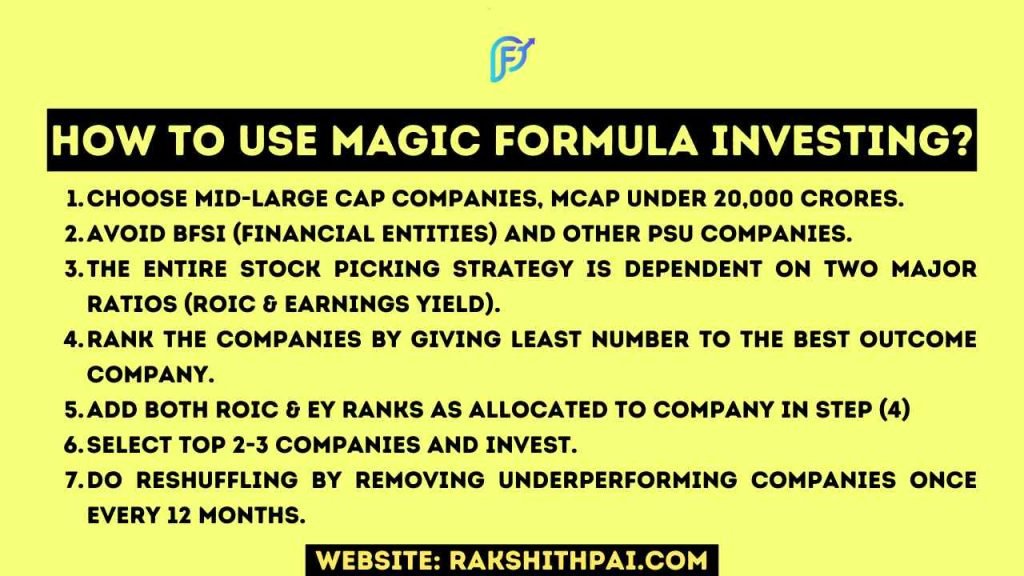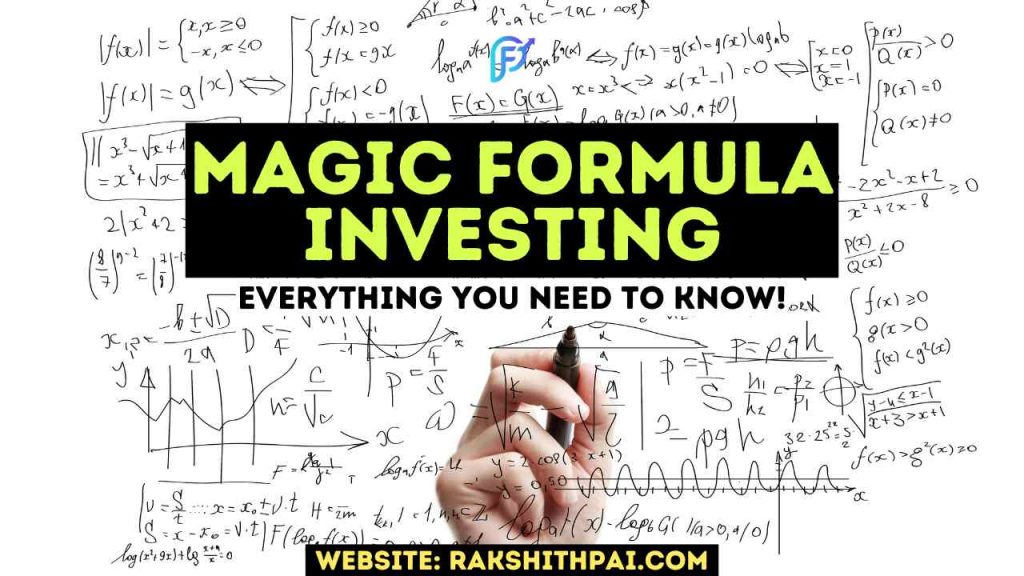Table of Contents
Introduction:
Investing, and especially value investing, has a reputation for being a difficult endeavor. Investing for value entails searching for stocks that are undervalued relative to their true worth and then purchasing those equities at a discount. Investors who focus on value want the stock price to go up until it matches or goes above what the company is really worth. This is called a capital appreciation gain.
This can only be done with rock-solid justification and confidence in a stock’s prospects for long-term growth. Selecting value stocks entails investigating the many factors that might affect the stock’s long-term price movement. It takes time and works to create such a solid foundation upon which to rest one’s investing selections. One option, though, is to follow the plan for investing laid out by a well-known investor and author.
Magic Formula Investing is based on a method that requires following a set of criteria to evaluate companies based on quantitative measures.
What is Magic Formula Investing?
The term “magic formula investing” is commonly used to describe a set of rules-based, disciplined investment guidelines that aim to instruct investors in a straightforward and user-friendly approach to value investing.
Using the Nifty 50, Sensex 30, or any such index as a proxy for market return, the strategy employs quantitative screens to identify firms and stocks with the potential to outperform the market over the long term. Price and return on capital are used to rate equities.
Magic Formula Investing explains how to take a cold, calculated, and emotionless approach to value investing. The technique, which was created by the investor, hedge fund manager, and management professor Joel Greenblatt, is only valid for large-cap equities.
Understanding Magic Formula Investing:
The Secret Formula depends on two ratios;
Earnings Yield
The first metric is the return on investment (EBIT/EV). This is calculated by dividing EBIT by the total company value. Earnings yield is calculated by dividing operating income by equity value.
[EY = EBIT/EV]
Earnings yield is calculated by dividing operating income by equity value.
This ratio can also be expressed as earnings to price, which is a more conventional and understandable form. EBIT is Greenblatt’s go-to metric instead of profits because it more fairly compares businesses with varying tax burdens.
Since EV takes debt into account in addition to equity, it is preferable to the share price. This means that EBIT/EV is a more accurate indicator of true profits than earnings per share.
How to Value Stocks Using Absolute PE Model
Return on Capital Invested
The return on capital may be calculated as follows: Earnings Before Interest and Taxes (EBIT) /(Net Fixed Assets + Working Capital).
ROIC = [EBIT/(NFA+WC)]
To figure out the return on invested capital, you divide EBIT by net operating income plus working capital.
Earnings per share (EPS) is a more standard and straightforward measure of this concept. Greenblatt prefers EBIT over net income because it lets him compare companies with different tax burdens in a more fair way.
Since it takes debt into account, equity value (EV) is preferred over the share price. Since earnings per share don’t show the whole picture of a company’s financial health, EBIT/EV is better.
How to Use Magic Formula?
Following the guidelines of the Magic Formula Investing strategy will result in a list of stocks with unquestionable worth. Explained in 7 steps;
- Magic Formula is used only on mid to large-cap well-established companies. Preferably a company with a market capitalization of at least 15 to 20,000 crores.
- The use of the Magic formula is not suggested for companies that deal with financial products & high leveraged PSU companies. The main reason for avoiding BFSI (Banking, Financial Services, and Insurance) & Public Sector Undertakings is that Mr.Greenblatt wishes to avoid highly leveraged entities.
- Preference to Companies with the following metrics;
- Earnings Yield – Earnings before interest and taxes (EBIT) divided by enterprise value (EV).
- Return on Invested Capital – Earnings before interest and taxes (EBIT) divided by Net Fixed Asset & Working Capital.
- The companies on the list must be ranked according to the best earnings yield and the highest return on capital, which can be done after computing the aforementioned ratios for each stock. Finally, combine the ranks of the two ratios and sort them upwards.
- After applying the aforementioned filter to the list, you will be left with a manageable subset from which to select the best two or three stocks to buy each month for a whole year.
- After 12 months, the portfolio must be rebalanced. This is achieved by unloading underperformers before the end of the year and selling overachievers in the new year. The goal of this strategy is to get the most out of the tax breaks that come with long-term capital gains.
- Repeat the same procedure for as long as feasible.

Advantages of Magic Formula Investing:
Easy to Use
Magic Formula is simple rule-based investing. And, since we already have all the required information available in the public domain regarding the ratios needed for Magic Formula, an investor just needs to impediment the same and invest accordingly.
Simplicity
The biggest benefit of the Magic Formula Investing method is how easy it is to implement. You just need to follow a set of rules and figure out if the investments you make based on those rules match your risk tolerance and desired rate of return.
Five (5) Golden Investment Principles that defined Mr. Warren Buffett!
Stress-Free
Magic Formula is an emotionless, purely analytical way of investing. One needs to follow the laid procedure and do nothing apart from what is asked for as per the formula. So, investors need not be emotionally charged when doing the research.
Beats Benchmark
Proper usage of Magic Formula has proven to beat benchmark returns on multiple occasions.
Disadvantages of Magic Formula Investing:
Past Performance
Bear in mind that the ratios employed in this method depend on previously collected data. There is no guarantee that the company’s operational or financial performance will stay the same or get better. This is because past performance is not a good indicator of future performance and returns.
Limited View
Market declines, geopolitical unrest, and changes in government policy that affect the market as a whole or the company’s industry, in particular, are only some of the aspects that aren’t taken into account by this method.
Rebalancing
Rebalancing one’s portfolio every year or half yearly is one of the major components for the formula to work. Failure to shuffle the portfolio by removing underperformers will cost investors dearly. Such constant tweaks will also hinder portfolio growth and the same undermine long-term investing.
Ratio Analysis
The entire stock picking strategy is dependent on two major ratios (ROIC & Earnings Yield). Thus, ignoring all other ratios and fundamental, technical tools.
Conclusion:
Overall, it’s fair to say that the Magic Formula approach to investing is relatively simple in comparison to other value investing methodologies and that it aids in taking a disciplined, rule-based approach to making investment decisions and exercising patience in order to generate returns over the long term (at least 5–10 years).
Keep in mind, however, that this is not a foolproof plan and is vulnerable to the impact given to your portfolio that the Magic Formula Investing method does not take into account.
The magic formula is an easy-to-understand set of guidelines for generating above-average returns for the ordinary investor. By using a straightforward procedure, the “magic formula” helps investors spot under-or overvalued businesses with ease, rather than being swayed by their gut or their emotions. Even if returns are lower now than when the magic formula was originally released, the strategy may still outperform the market with certain tweaks.
Disclaimer: All the information on this website is published in good faith and for general information purposes only.









